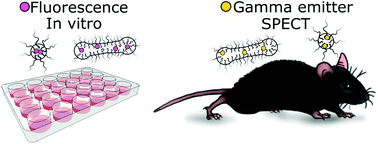In vivo biodistribution of stable spherical and filamentous micelles probed by high-sensitivity SPECT†
Abstract
Understanding how nanoparticle properties such as size, morphology and rigidity influence their circulation time and biodistribution is essential for the development of nanomedicine therapies. Herein we assess the influence of morphology on cellular internalization, in vivo biodistribution and circulation time of nanocarriers using polystyrene-b-poly(ethylene oxide) micelles of spherical or elongated morphology. The glassy nature of polystyrene guarantees the morphological stability of the carriers in vivo and by encapsulating Indium-111 in their core, an assessment of the longitudinal in vivo biodistribution of the particles in healthy mice is performed with single photon emission computed tomography imaging. Our results show prolonged blood circulation, longer than 24 hours, for all micelle morphologies studied. Dynamics of micelle accumulation in the liver and other organs of the reticuloendothelial system show a size-dependent nature and late stage liver clearance is observed for the elongated morphology. Apparent contradictions between recent similar studies can be resolved by considering the effects of flexibility and degradation of the elongated micelles on their circulation time and biodistribution.


 Please wait while we load your content...
Please wait while we load your content...